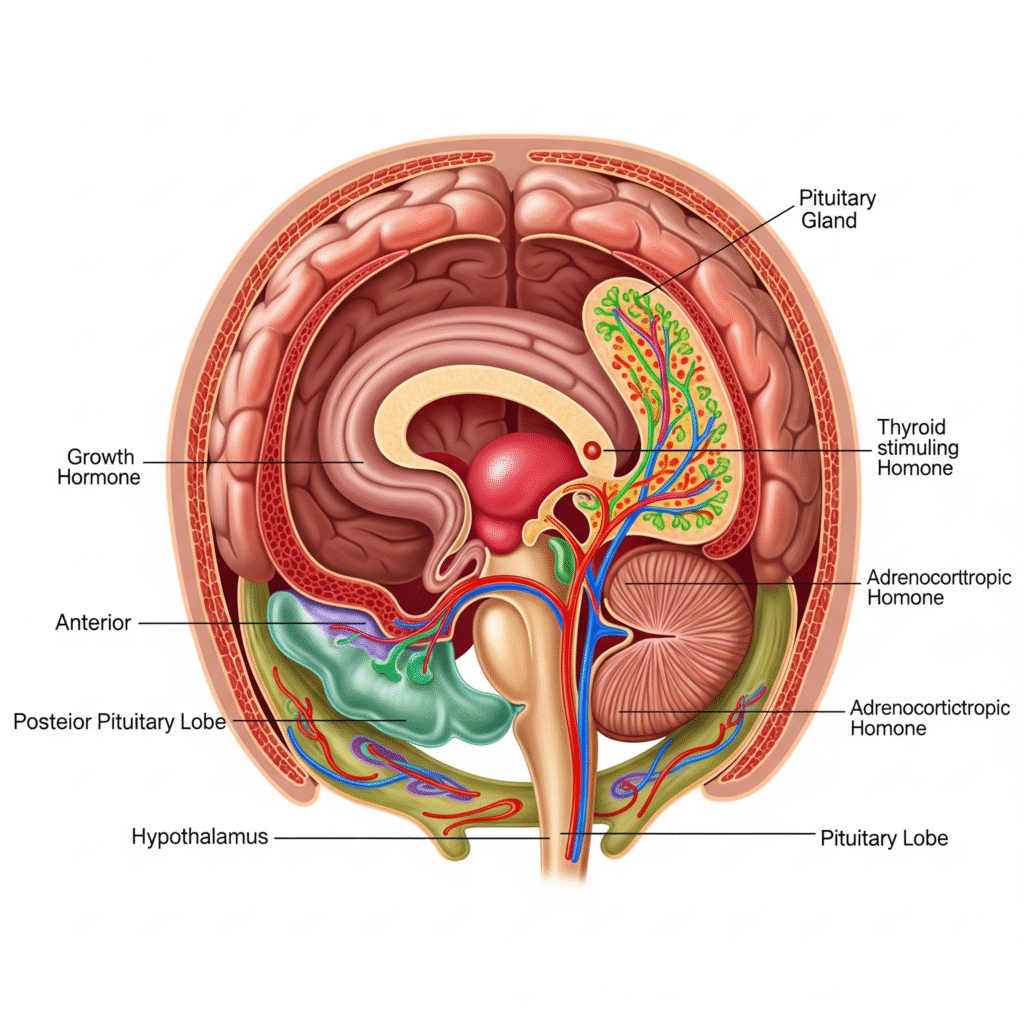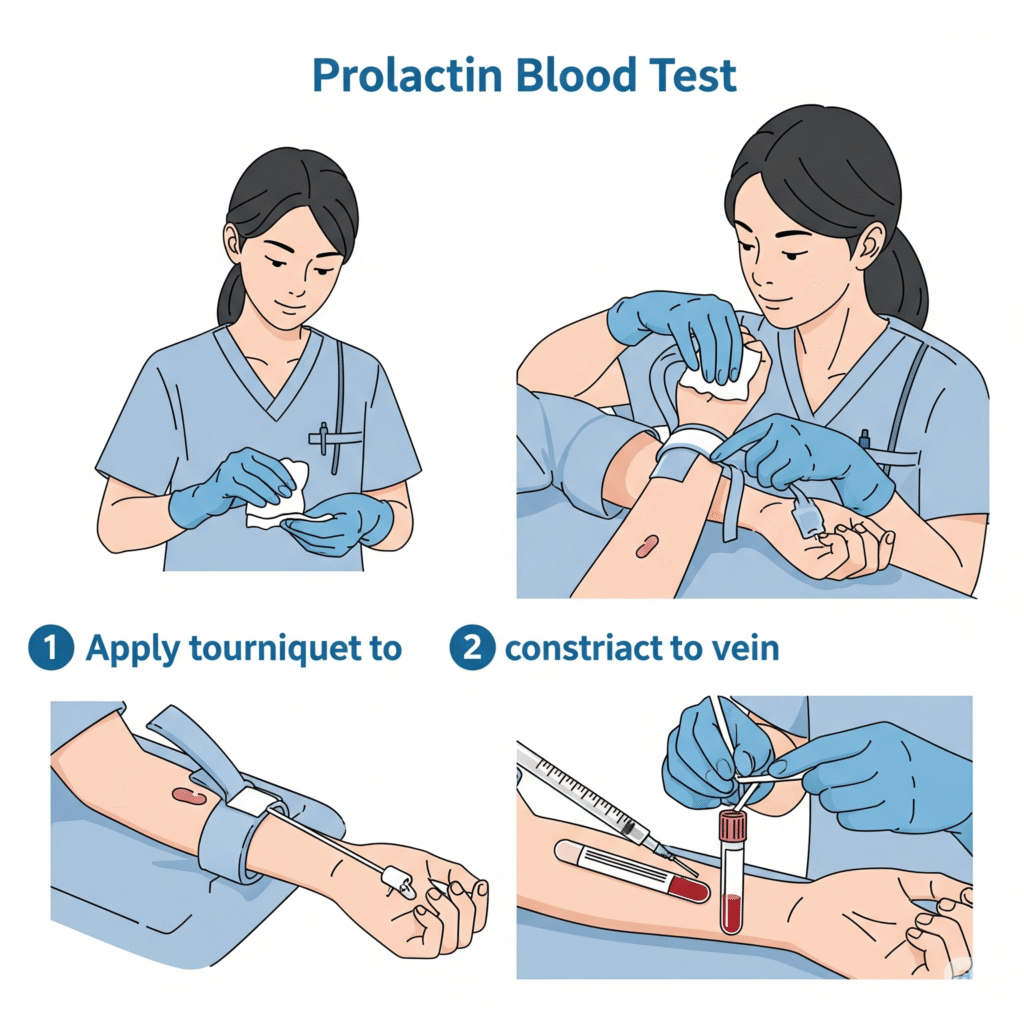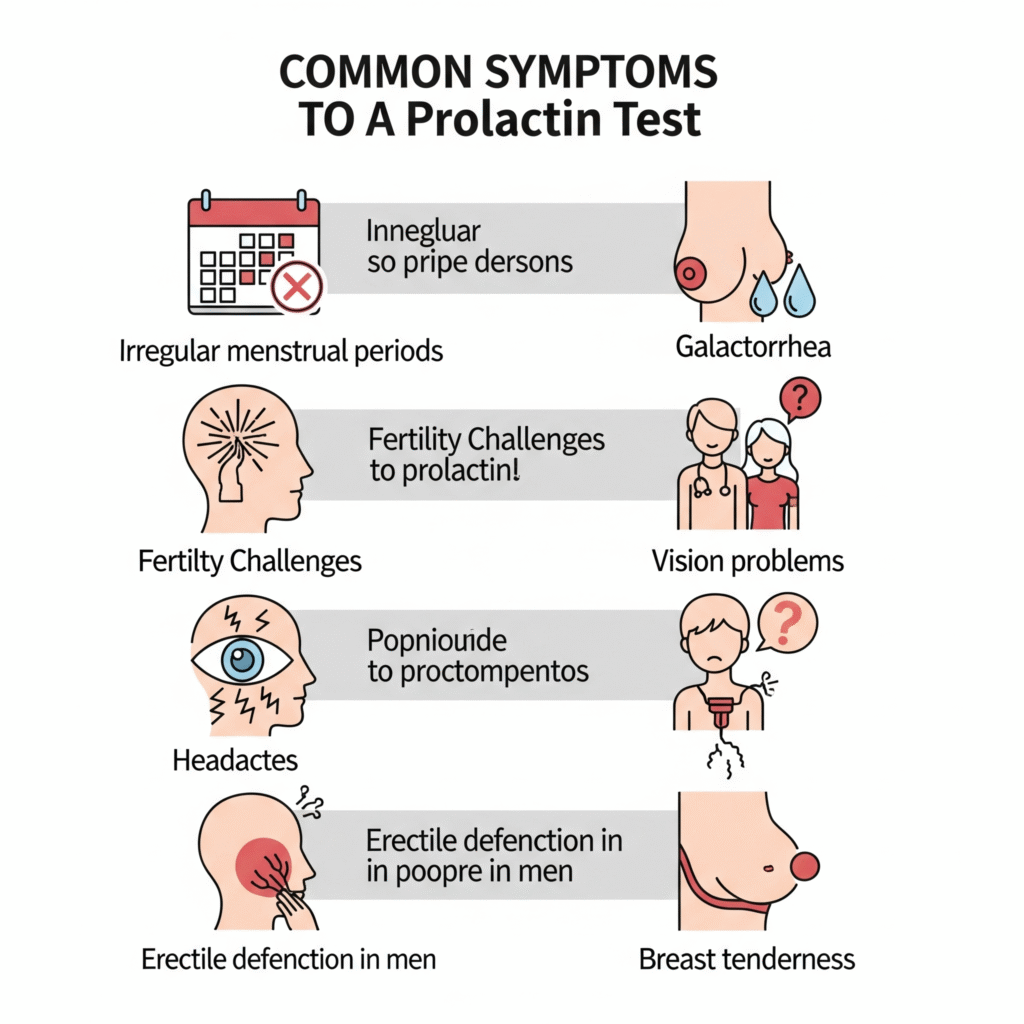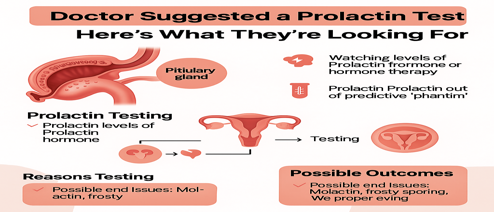Have you just been handed a lab slip and noticed the term “prolactin test” circled? You’re not alone. Many people are caught off guard when their doctor suggests checking prolactin levels, especially if they aren’t familiar with this lesser-known hormone. But trust us—there’s a good reason behind it.
Whether you’re dealing with irregular periods, unexpected milk production, or unexplained infertility test, a prolactin test can be a key to unlocking what’s going on inside your body. In this article, we’ll unpack everything you need to know about prolactin, why your doctor wants it tested, what the results mean, and what comes next.
Understanding Prolactin – The Hormone Explained

What is Prolactin?
Prolactin is a hormone produced by the pituitary gland—a pea-sized structure located at the base of the brain. Though it doesn’t get as much spotlight as hormones like estrogen or testosterone, prolactin plays a vital role in your body, especially when it comes to reproductive health.
The primary job of prolactin is to stimulate breast development and milk production in women. But that’s not all it does. This hormone also influences behavior, immune system function, and even metabolic processes in both men and women. Prolactin levels naturally fluctuate depending on various factors like stress, sleep, and physical activity.
It’s important to understand that prolactin is always present in your body at low levels. However, it becomes clinically significant when those levels rise (or sometimes drop) beyond the normal range, which is exactly what your doctor is trying to detect with a prolactin test.
Where is Prolactin Produced in the Body?
The star player in prolactin production is your anterior pituitary gland. Nestled snugly in the sella turcica—a bony structure at the base of your skull—the pituitary gland is like the control tower for your body’s hormonal activity. When it receives the right signals from your hypothalamus, it releases prolactin into your bloodstream.
Interestingly, prolactin is also produced in small quantities in other tissues such as the uterus, immune cells, and even the skin. But these local productions are minor and mostly serve autocrine or paracrine functions, meaning they act in the cells where they’re produced rather than traveling through the bloodstream.
Functions of Prolactin in Males and Females
In women, prolactin is primarily responsible for:
- Stimulating breast growth during puberty and pregnancy
- Initiating and maintaining lactation after childbirth
- Modulating the menstrual cycle
In men, prolactin may not have a starring role, but it still contributes to:
- Regulating testosterone production
- Influencing sperm development
- Affecting libido and sexual function
When levels go haywire—too high or too low—it can lead to symptoms that range from mild to disruptive. That’s why testing is critical when a doctor suspects a hormonal imbalance.
Why Doctors Recommend a Prolactin Blood Test
Common Symptoms That Trigger a Prolactin Test
Doctors don’t usually order a prolactin test on a whim. There are often distinct red flags or symptoms that prompt the need to measure this hormone. Some of the most common symptoms include:
- Irregular or missed menstrual periods
- Unexplained breast milk production (galactorrhea)
- Fertility challenges
- Erectile dysfunction or decreased libido in men
- Persistent headaches or vision problems (linked to pituitary tumors)
- Unexplained breast tenderness or changes
Each of these symptoms can suggest an imbalance in prolactin levels. So, if you’ve been experiencing any of the above, it’s no wonder your doctor wants a closer look.
Prolactin Test for Fertility Issues
Prolactin plays a surprisingly important role in fertility. High prolactin levels can inhibit ovulation in women, making it nearly impossible to conceive naturally. In men, elevated prolactin can lower testosterone, leading to a reduced sperm count and fertility problems.
A prolactin test is often one of the first steps in investigating reproductive issues. For women struggling with conception or irregular cycles, identifying and treating hyperprolactinemia can significantly improve chances of becoming pregnant. Likewise, men with unexplained infertility may discover that high prolactin levels are impacting their reproductive capabilities.
Hormonal Imbalance and the Role of Prolactin
Prolactin doesn’t work in isolation. It’s part of a complex network of hormones that regulate everything from stress response to metabolism. When prolactin is out of balance, it often signals a larger issue with the endocrine system.
For instance, a tumor on the pituitary gland (prolactinoma) can lead to elevated prolactin levels. Likewise, thyroid dysfunction—especially hypothyroidism—can also cause increased prolactin production. Your doctor may order additional hormone tests alongside prolactin to get the full picture.
So, when your doctor requests a prolactin test, they’re not just checking for one isolated issue—they’re opening a window into your overall hormonal health.
How the Prolactin Test is Performed

Preparation Before the Test
Luckily, preparing for a prolactin test is relatively straightforward, but there are a few tips that can ensure more accurate results:
- Avoid stress and intense physical activity 24 hours before the test
- Refrain from sexual activity the night before, as it can temporarily elevate prolactin
- Get a good night’s sleep, since poor sleep can influence hormone levels
- Fast if your doctor advises—although it’s not always required, some providers recommend fasting to stabilize hormone levels
Being calm and relaxed at the time of the test helps get the most accurate snapshot of your baseline prolactin levels.
What Happens During the Test?
A prolactin test is a simple blood draw, usually taken from a vein in your arm. The process takes only a few minutes:
- A healthcare professional will clean the skin with an antiseptic.
- A tourniquet is applied to make your veins more visible.
- Blood is drawn into a tube and sent to the lab for analysis.
That’s it—quick and minimally invasive.
When is the Best Time to Take the Test?
Timing can influence the results significantly. Prolactin levels are highest during sleep and early morning hours, so most doctors recommend getting tested early—usually within three hours of waking up. Avoid scheduling your test too late in the day, as this could yield lower or misleading results.
For women, the phase of the menstrual cycle can also have an impact, so be sure to inform your provider of your cycle timing if you’re menstruating.
Interpreting Prolactin Test Results
Normal Prolactin Levels in Men and Women
Interpreting prolactin levels depends on a range of factors including sex, age, and physiological state (like pregnancy). Here’s a general breakdown:
| Group | Normal Prolactin Range (ng/mL) |
| Non-pregnant women | 4.8 – 23.3 |
| Pregnant women | Up to 400 |
| Men | 4.0 – 15.2 |
These values might slightly vary depending on the lab’s reference range.
High Prolactin Levels: What They Indicate
When your prolactin levels are elevated beyond the normal range, it’s a condition known as hyperprolactinemia. This isn’t always a sign of something serious—but it’s definitely something that needs attention. The implications can vary depending on how high the levels are and what symptoms you’re experiencing.
Mild elevations may be linked to:
- Physical or emotional stress
- Recent sexual activity
- Inadequate sleep
- Intense physical exercise
Moderate to severe increases can point to more significant issues, such as:
- Pituitary tumors (prolactinomas): These are non-cancerous growths on the pituitary gland that directly boost prolactin production.
- Hypothyroidism: An underactive thyroid increases TRH (thyrotropin-releasing hormone), which in turn stimulates prolactin release.
- Polycystic ovary syndrome (PCOS): Some women with PCOS have slightly elevated prolactin levels.
Symptoms to watch for include irregular periods, infertility, galactorrhea, vision disturbances, and in men, loss of libido or erectile dysfunction. Identifying the root cause early allows for targeted treatment—often leading to full recovery of hormonal balance.
Low Prolactin Levels and Their Implications
Although less common, low prolactin levels can also be problematic. When prolactin levels are abnormally low, doctors refer to this condition as hypoprolactinemia. It may not get as much attention, but it still warrants evaluation—especially if linked to fertility or pituitary dysfunction.
Possible causes include:
- Pituitary insufficiency or damage: Sometimes due to trauma, surgery, or radiation therapy.
- Certain medications: Especially dopamine agonists like bromocriptine or cabergoline.
- Postpartum pituitary necrosis (Sheehan’s syndrome): A rare complication following severe blood loss during childbirth.
Low prolactin can disrupt lactation in new mothers and affect immune system regulation. In some rare cases, it may also be associated with delayed puberty or impaired reproductive function in both sexes.
Doctors usually look at low prolactin levels in the context of other hormonal tests, since isolated hypoprolactinemia is rare and often not clinically significant unless tied to broader endocrine issues.
Causes of High Prolactin Levels (Hyperprolactinemia)
Physiological Causes of Elevated Prolactin
Not all elevated prolactin levels are a sign of disease. In fact, there are many normal, physiological reasons your prolactin might spike temporarily:
- Pregnancy and breastfeeding: This is the most natural cause. Prolactin increases to prepare the breasts for milk production.
- Sleep: Prolactin levels peak during REM sleep and early morning hours.
- Sexual activity: Prolactin rises briefly after orgasm in both men and women.
- Stress: Emotional and physical stress can significantly increase prolactin, at least temporarily.
In such cases, the elevation is typically mild and returns to normal without treatment. Doctors often ask about these factors when interpreting slightly elevated test results.
Medical Conditions Leading to High Prolactin
If your prolactin levels remain high over time, there may be an underlying medical condition. Some of the most common include:
- Pituitary adenomas (prolactinomas): These benign tumors cause excessive prolactin secretion and are among the leading causes of chronic hyperprolactinemia.
- Hypothyroidism: Low thyroid hormones lead to increased TRH, which stimulates the release of prolactin.
- Kidney disease: Chronic renal failure can impair prolactin clearance, causing it to build up in the blood.
- Polycystic ovary syndrome (PCOS): Women with PCOS may have higher baseline prolactin levels.
- Chest wall injuries or stimulation: Trauma, surgery, or even shingles around the chest can increase prolactin by stimulating nerve pathways connected to the breast.
When a medical condition is suspected, further diagnostic tests like MRIs or thyroid panels are typically ordered to pinpoint the exact cause.
Medication-Induced Hyperprolactinemia
Believe it or not, many medications can lead to increased prolactin production. These include:
- Antipsychotics: Such as risperidone, haloperidol, and olanzapine
- Antidepressants: SSRIs can sometimes cause elevated prolactin
- Blood pressure medications: Like verapamil
- Estrogen-based drugs: Including some birth control pills
These medications often work by affecting dopamine pathways, which in turn regulate prolactin production. When dopamine is suppressed (as with many antipsychotics), prolactin levels tend to rise.
Doctors often review a full medication history before concluding the source of prolactin imbalance. In some cases, switching to an alternative drug or adjusting the dose may resolve the issue without further treatment.
Symptoms of Abnormal Prolactin Levels

Signs of High Prolactin in Women
High prolactin levels manifest differently in women, often disrupting the reproductive cycle. Common symptoms include:
- Irregular or absent periods: Prolactin suppresses ovulation by inhibiting GnRH, the hormone that stimulates the ovaries.
- Infertility: Without ovulation, getting pregnant becomes difficult.
- Galactorrhea: This is the spontaneous flow of milk from the breasts, unrelated to childbirth or nursing.
- Low sex drive: High prolactin interferes with estrogen production, leading to reduced libido.
- Breast tenderness or enlargement not linked to the menstrual cycle.
In some cases, especially when a prolactinoma is present, additional symptoms may arise due to pressure on surrounding tissues, such as:
- Persistent headaches
- Blurred or double vision
- Reduced peripheral vision
Signs of High Prolactin in Men
Though prolactin’s role in men is less prominent, elevated levels can still lead to significant symptoms:
- Decreased libido and sexual dysfunction
- Erectile dysfunction
- Infertility due to reduced sperm count or motility
- Gynecomastia: Enlargement of breast tissue
- Galactorrhea: Although rare, some men may experience milk production
- Loss of muscle mass or fatigue, stemming from low testosterone
Because these symptoms are often mistaken for stress or lifestyle issues, prolactin testing is crucial for proper diagnosis.
Treatments for High Prolactin Levels
Medication for Prolactin Regulation
In most cases, high prolactin can be treated effectively with medication. The primary class used is dopamine agonists, which help restore the natural balance by inhibiting prolactin release.
Common medications include:
- Cabergoline
- Bromocriptine
These drugs not only reduce prolactin levels but also shrink pituitary tumors when present. Most people respond well, often seeing hormone levels normalize within weeks or months.
Surgical Intervention for Prolactinomas
If medication fails or if a tumor is large and affecting vision or brain function, surgery may be necessary. The most common approach is transsphenoidal surgery, where the tumor is removed through the nasal passage, minimizing risk and recovery time.
This option is considered when:
- Medication causes severe side effects
- The tumor is unresponsive to drug therapy
- There’s a rapid loss of vision
Lifestyle Adjustments and Monitoring
While lifestyle changes alone won’t cure hyperprolactinemia, they can support your treatment plan:
- Managing stress through yoga, therapy, or meditation
- Getting adequate sleep to support hormonal rhythms
- Avoiding stimulants that may affect hormone levels
- Tracking menstrual cycles or libido changes for early warning signs
Regular blood tests are essential to monitor prolactin levels and ensure your treatment remains effective.
Treatments for Low Prolactin Levels
Unlike hyperprolactinemia, hypoprolactinemia is not commonly treated unless it’s part of a broader pituitary disorder. Here’s how it’s typically managed:
Treating Underlying Pituitary Disorders
If low prolactin is due to pituitary insufficiency, your doctor will likely focus on:
- Hormone replacement therapy (e.g., cortisol, thyroid hormones)
- Addressing root causes like tumors or head trauma
- MRI imaging to evaluate pituitary structure
Improving Lactation in New Mothers
For mothers who cannot produce breast milk due to low prolactin, supportive steps include:
- Using galactagogues (natural or medical substances to stimulate lactation)
- Breastfeeding frequently to encourage hormonal response
- Ensuring adequate nutrition and hydration
Monitoring Other Hormone Levels
Because low prolactin is rare, doctors often check for broader hormone deficiencies including LH, FSH, estrogen, and testosterone. If necessary, hormone therapies may be considered to maintain reproductive and metabolic health.
Follow-Up Tests After Abnormal Prolactin Results
If your prolactin test results are abnormal, your doctor may order additional tests to dig deeper:
MRI Scan of the Pituitary Gland
This is the go-to imaging test when a tumor is suspected. MRI provides a detailed view of the pituitary, allowing doctors to:
- Detect tumors (prolactinomas)
- Determine their size
- Check for pressure on nearby nerves or tissues
Thyroid Function Tests
Since hypothyroidism can elevate prolactin, TSH test and free T4 levels are usually checked. Treating thyroid dysfunction often brings prolactin levels back to normal without any direct hormone therapy.
Blood Tests for Other Hormones
To get a complete picture, your doctor may also test for:
- Estrogen and progesterone (in women)
- Testosterone T (in men)
- LH, FSH, ACTH, and cortisol for evaluating pituitary function
This comprehensive approach ensures nothing is overlooked and the most accurate diagnosis is made.
The Link Between Prolactin and Mental Health
You might be surprised to learn that prolactin and mental health are more closely related than most people think.
Mood Changes and Prolactin Levels
- Elevated prolactin can lead to mood disturbances such as depression, anxiety, and emotional instability.
- Women with high prolactin often report low self-esteem and body image issues due to changes like unwanted lactation or weight gain.
- In men, low testosterone triggered by high prolactin can cause fatigue, brain fog, and lack of motivation.
Psychiatric Medications and Prolactin
Several medications used to treat mental health disorders directly affect dopamine, which in turn alters prolactin production:
- Antipsychotics, especially risperidone and haloperidol, can significantly raise prolactin
- SSRIs and certain mood stabilizers also have mild prolactin-elevating effects
It’s essential to work closely with your healthcare provider to balance mental health needs with hormonal stability. In some cases, switching medications or adding a prolactin-lowering agent can alleviate both mental and physical symptoms.
When to See an Endocrinologist for Prolactin Issues
While a general physician can order a prolactin test, sometimes you’ll need to consult an endocrinologist—a doctor who specializes in hormonal disorders.
Situations That Require Specialist Evaluation
- Your prolactin levels are consistently abnormal
- You’ve been diagnosed with a pituitary tumor
- You experience severe symptoms affecting vision, menstrual cycles, or fertility
- You’re not responding to initial treatment
An endocrinologist will conduct a thorough evaluation, coordinate imaging tests, and design a tailored treatment plan to address the root of your prolactin imbalance.
Conclusion
If your doctor has recommended a prolactin test, take it seriously—but don’t panic. Whether your levels are too high or too low, understanding what’s happening in your body is the first step toward getting the right treatment.
Prolactin might not be a household name like estrogen or testosterone, but it plays a crucial role in both physical and emotional well-being. From fertility and sexual health to mood and metabolic function, this hormone is far more influential than it gets credit for.
Remember, most prolactin-related conditions are manageable—especially when detected early. So, if you’ve been feeling “off” or your symptoms don’t quite add up, a prolactin test might just be the clue you and your doctor need.
FAQs
1. Can stress alone raise prolactin levels?
Yes, both emotional and physical stress can cause temporary spikes in prolactin. It’s best to relax before a test to avoid skewed results.
2. Is a prolactin test only for women?
No. While it’s more commonly discussed in women’s health, prolactin tests are also important for diagnosing issues in men, especially related to fertility and libido.
3. How long do prolactin medications take to work?
Dopamine agonists can begin lowering prolactin levels within a few weeks, though full normalization may take several months depending on the cause.
4. Can I still get pregnant with high prolactin?
It’s possible, but high prolactin often suppresses ovulation. Treating the underlying cause usually improves fertility outcomes.
5. Are prolactinomas cancerous?
No. Prolactinomas are typically benign (non-cancerous) tumors and respond well to medication in most cases.


Leave a Reply